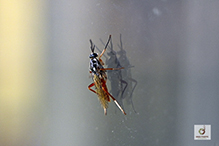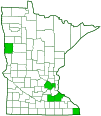wood soldier fly
(Xylomya americana)
Conservation • Description • Habitat • Ecology • Distribution • Taxonomy
Conservation Status |
|
|||||||
| IUCN Red List | not listed |
|||||||
| NatureServe | NNR - Unranked |
|||||||
| Minnesota | not listed |
|||||||
Description |
||
Xylomya americana is a small wood soldier fly. It occurs in the United States and southern Canada east of the Great Plains. Adults are found on herbaceous vegetation in shaded, woody areas. The male is slender and 5⁄16″ to 7⁄16″ (8.2 to 10.5 mm) in length. The female is slightly larger, ⅜″ to 7⁄16″ (9.0 to 10.9 mm) in length. The head is hemispherical when viewed from the side. The antennae are brownish-gray to black. They have three segments, a scape at the base, a short pedicel, and a flagellum at the end. The scape is short but is longer than the pedicel. The flagellum is ringed (annulated), making it appear to have eight sections, but this is difficult to see except in strong light. There is a short, pointed style on the last section. The face is rounded when viewed from the side. The forehead (frons), cheeks (genae), and plate on the face (clypeus) are black. The feeler-like mouthparts (maxillary palps) are yellow. The thorax is somewhat shiny and brownish-gray to black with yellow spots and stripes. It is rounded when viewed from the side. It has three sections, from front to back the prescutum, scutum, and scutellum. A longitudinal groove (transverse suture) separates the prescutum and the scutum. The scutellum is broad and is rounded at the rear. There is a spot on the front corners of the prescutum, a spot on each side at the transverse suture, a spot on each side on the rear half of the scutum, and a spot at the rear of the scutellum. Two narrow, yellow, longitudinal stripes extend from the spots on the prescutum to the middle of the scutum. The abdomen is mostly dull brick red with a narrow yellow band on the rear margin of each segment. The first segment is brownish-gray above, yellow on the sides. The wings are clear with brown veins. The radial sector (Rs) vein has three branches. The branches are crowded together toward the wing tip, but the last branch (R5) ends before the wing tip. The anal cell is longer than the second basal cell and is closed near the wing margin. The fourth posterior cell (M3) is closed. The legs are moderately long. The last part of each leg (tarsus), corresponding to the foot, has five segments (tarsomeres). On the front legs the third segment (femur), the basal third of the fourth segment (tibia), and the first segment of the tarsus (tarsomere 1) are yellow, the remaining parts are brownish-gray to black. On the middle legs, the femur is yellow on the basal half, dull brick red on the outer half; the tibia is mostly brick red, yellow just at the base; tarsomere 1 is yellow and tarsomeres 2 through 5 are brownish-gray to black. On the hind leg the femur is not enlarged, and the basal half is yellow. The outer half of the femur and all of the tibia are dull brick red. Tarsomeres 1 and 2 are yellow, 3 through 5 are brownish-gray to black. |
||
Size |
||
Female total length: ⅜″ to 7⁄16″ (9.0 to 10.9 mm) Male total length: 5⁄16″ to 7⁄16″ (8.2 to 10.5 mm) |
||
Similar Species |
||
Habitat |
||
|
||
Ecology |
||
Season |
||
|
||
Behavior |
||
Larvae are found under bark or in decaying wood. Adults are sluggish and inactive, and may not escape when approached. |
||
Life Cycle |
||
|
||
Larva Food |
||
|
||
Adult Food |
||
|
||
Distribution |
||||
|
Sources Webb, D. W. (1984). A Revision of the Nearctic Species of the Family Solvidae (Insecta: Diptera). Transactions of the American Entomological Society (1890-), 110(2), 245–293. http://www.jstor.org/stable/25078339 |
|||
| 6/16/2023 | ||||
Occurrence |
||||
|
||||
Taxonomy |
|||
Order |
Diptera (Flies) | ||
Suborder |
Brachycera | ||
| Infraorder | Orthorrhapha | ||
Parnorder |
Stratiomyomorpha (soldier flies and allies) | ||
Superfamily |
Stratiomyoidea | ||
Family |
Xylomyidae (wood soldier flies) | ||
Genus |
Xylomya | ||
Synonyms |
|||
Macroceromys americanus Xylophagus americana |
|||
Common Names |
|||
This species has no common name. The common name of the family Xylomyidae is wood soldier flies, and it is applied here for convenience. |
|||
Glossary
Clypeus
On insects, a hardened plate on the face above the upper lip (labrum).
Frons
The upper front part of an insect’s face, roughly corresponding to the forehead.
Gena
In insects: The area between the compound eye and the mandible; the cheek. In birds: The area between the the angle of the jaw and the bill; the feathered side (outside) of the under mandible. Plural: genae.
Scutellum
The exoskeletal plate covering the rearward (posterior) part of the middle segment of the thorax in some insects. In Coleoptera, Hemiptera, and Homoptera, the dorsal, often triangular plate behind the pronotum and between the bases of the front wings. In Diptera, the exoskeletal plate between the abdomen and the thorax.
Scutum
The forward (anterior) portion of the middle segment of the thorax (mesonotum) in insects and some arachnids.
Tarsus
On insects, the last two to five subdivisions of the leg, attached to the tibia; the foot. On spiders, the last segment of the leg. Plural: tarsi.
Tibia
The fourth segment of an insect leg, after the femur and before the tarsus (foot). The fifth segment of a spider leg or palp. Plural: tibiae.
Visitor Photos |
|||||
Share your photo of this insect. |
|||||
| This button not working for you? Simply email us at info@MinnesotaSeasons.com. Attach one or more photos and, if you like, a caption. |
|||||
Mike Poeppe |
|||||
 |
|||||
MinnesotaSeasons.com Photos |
|||||
|
|||||

Slideshows |
||

Visitor Videos |
|||
Share your video of this insect. |
|||
| This button not working for you? Simply email us at info@MinnesotaSeasons.com. Attach a video, a YouTube link, or a cloud storage link. |
|||
Other Videos |
|||

Created: 6/16/2023
Last Updated:


